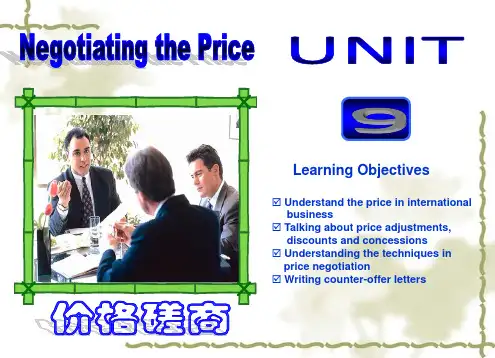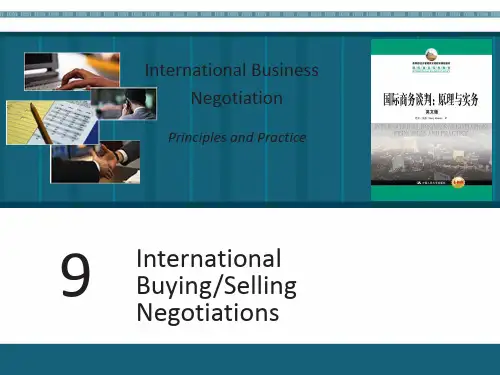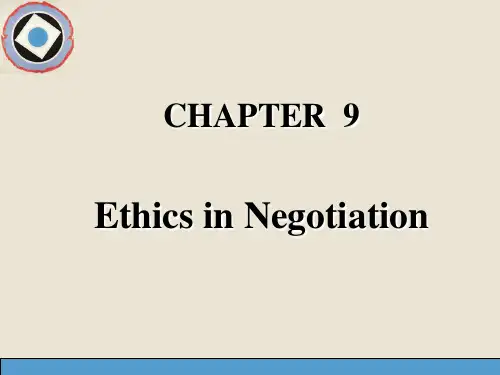- 1、下载文档前请自行甄别文档内容的完整性,平台不提供额外的编辑、内容补充、找答案等附加服务。
- 2、"仅部分预览"的文档,不可在线预览部分如存在完整性等问题,可反馈申请退款(可完整预览的文档不适用该条件!)。
- 3、如文档侵犯您的权益,请联系客服反馈,我们会尽快为您处理(人工客服工作时间:9:00-18:30)。
P2
P3
2. Coalitions
P1
P2
P3
4. Constituencies
C1
C3
P1
P2
C2
C4
5. Team Negotiation
P
M MM
3. Principal -Agent
P1
A1
A2
P2
P: principal; C: constituency group; M: group member; A: agent
9-9
Analyzing Multiparty Negotiations
Strategies negotiators might use to enhance their ability to expand and slice the pie in a multiparty context (continued):
• Shop around. (Exhibit 9-7) • Know your BATNA before meeting with your
agent. • Communicate your interests to your agent
without giving away your BATNA. • Capitalize on the agent’s expertise. • Tap into you agent’s sources of information. • Use agent networks.
9-3
Analyzing Multiparty Negotiations
Exhibit 9-1
9-4
Analyzing Multiparty Negotiations
Exhibit 9-2:
1. Multiparty
Levels of analysis in a
P1
multiparty
negotiation
9-7
Analyzing Multiparty Negotiations
A variety of paradoxes can affect groups aggregating the preferences of team members through voting, such as:
• Condorcet paradox • Impossibility theorem • Strategic voting • Consensus agreements
9-14
Principal-Agent Negotiations
Exhibit 9-6:
The bargaining zone, maximum surplus, and agent commission rates for a house sale
Commission 0% (for sale by owner) 2% 4% 5% 6%
Agents’ Surplus Range
$0
$8,367–$8,800 $17,083–$17,600 $21,579–$22,000 $26,170–$26,400
Note: RP = reservation price. In this example, assume that the house is originally listed for sale at $450,000; assume that the buyer’s is $440,000 and the seller’s reservation price is $410,000. If no agency fees were involved, the bargaining range is $30,000 (i.e., any price between $410,000 and $440,000). The agent commission fees mean that the seller must adjust his or her reservation price upward. For example, if the agent commission rate is 6%, the seller cannot sell below $436,170.
Sel ler RP $4 10 ,0 00 $4 18 ,3 67
$4 27 ,0 83 $4 31 ,5 78 $4 36 ,1 70
B uyer R P Asking Price $4 40 ,0 00 $4 50 ,0 00
actual bargaining zone = $25,000
bargaining zone with 2% commission
9-6
Analyzing Multiparty Negotiations
If not used wisely, voting rules and the use of majority rule can thwart effective negotiations.
• Majority rule fails to recognize the strength of individual preferences.
bargaining zone with 4% commission bargaining zone with 5% commission bargaining zone with 6% commission
9-15
Principal-Agent Negotiations
The following are strategies for negotiators who want to work effectively with agents.
• A multiparty negotiation is a group of three or more individuals, each representing his or her own interests, attempting to resolve perceived differences of interest.
the pie.
9-12
Principal-Agent Negotiations:
Advantages
Many advantages can be realized by using agents to represent one’s interests in a negotiation, such as:
$30,000 $30,000
$418,367
$21,633
$21,633 $21,200
$427,083
$12,917
$12,91722
$8,422 $8,000
$436,170
$3,830
$3,830 $3,600
BargaiBnargianiningg ZoneZone
6. Intergroup
P1 M
MM
P2
M MM
9-5
Analyzing Multiparty Negotiations
There are several challenges of multiparty negotiations:
• Dividing resources • Coalitions • Formulating trade-offs • Voting and majority rule (Exhibit 9-3)
• Consequently, majority rule does not promote integrative tradeoffs among issues.
• Groups negotiating under unanimous rule reach more efficient outcomes than groups operating under majority rule.
9-11
Coalitions
The following are interpersonal strategies for effectively navigating coalitions and maximizing their effectiveness.
• Make your contacts early. • Seek verbal commitments. • Use unbiased-appearing rationale to divide
• Strive for equal participation. • Allow for some points of agreement, even if only
on process. • Avoid the “equal shares” bias. • Avoid the agreement bias. • Avoid sequential bargaining.
Disadvantages
On the reverse, there are disadvantages to using agents to represent one’s interests in a negotiation, such as:
• Shrinking ZOPA (Exhibit 9-6) • Incompatible incentive structure • Loss of control • Agreement at any cost
9-8
Analyzing Multiparty Negotiations
Given that multiparty negotiations present special challenges, the following are strategies negotiators can use to enhance their ability to expand and slice the pie in a multiparty context.





![国际商务谈判(英文版)chapter9 Skills of Body Language in Business Negotiation[精]](https://uimg.taocdn.com/86128a35e87101f69e31958c.webp)




